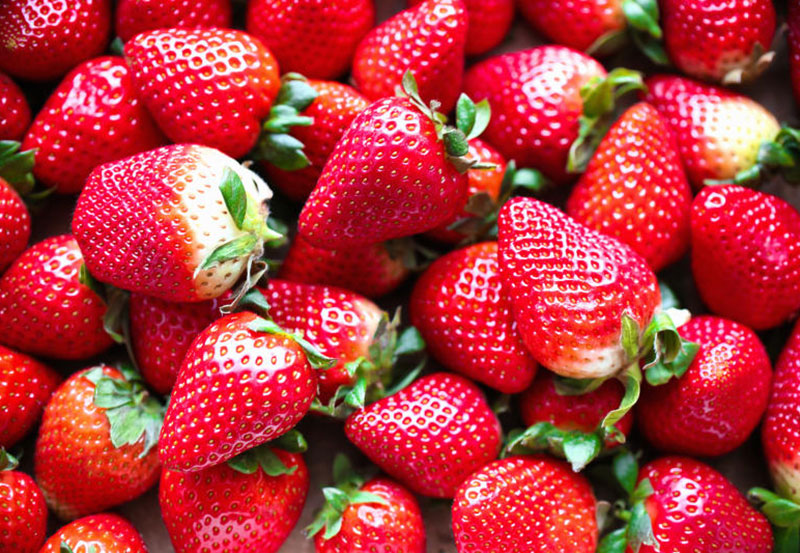A-Z of growing big and healthy strawberries

Strawberries are one of the highest value per-acre crops grown in Kenya. With good crop husbandry, the yield ranges from 2 tons to 10 tons per acre annually.
They are incredibly easy to grow and manage. However, simple mistakes and negligence can lead to yield reduction and losses. The following practices will help reduce damage from insects and diseases.
Sunlight
Strawberries need full sunlight to grow and produce fruits. It is therefore recommended that you do not shade the crop. Heat from the sun helps both leaves and fruit dry quickly after rain or overhead irrigation. This rapid drying reduces chances of diseases on the crop.
Ensure proper air drainage and circulation in the strawberry garden. Air circulation ensures rapid drying of the crop hence reducing potential of infection. Botrytis (gray mold) which is a common strawberry disease, thrives on wet foliage or fruit. Similarly, it is important that the soil dries out quickly after rain.
Infections
To control soil borne fungi infection, avoid waterlogging in the strawberry field as this would increase the likelihood of disease infection in the root system. Red stele and verticillium are two soil fungi that can infect strawberry root systems more easily in wet soil. Two important methods for accomplishing this are to maintain narrow rows and a low plant density within each row.
Watch out for runoffs within the field. Running water could be a source of disease organisms spreading from one crop to the other. Diseases such as red stele, verticillium, and black root rot can be carried in runoff water from a diseased planting to a healthy planting. Avoid planting new fruit plantings below older, diseased plantings.
Varieties
Choose disease resistant varieties. Some varieties are more susceptible to certain diseases or are less susceptible than other varieties.
Resistance or tolerance to diseases will eliminate or greatly reduce the need for disease control. Plant only disease-free planting material. Since viruses cannot be seen at the time of planting, the grower must rely on good propagation and cultural practice methods used by the nursery in producing the plants. Virus-infected plants are infected for life, and plants infected with soil-inhabiting fungi can contaminate the site for many years. Buy only healthy plants from reputable nurseries.
Change the growing fields after three seasons to reduce chances of disease build up. Some crops can build disease organisms in the soil, which can devastate the next crop if it is susceptible to the disease. Strawberries should not follow tomatoes, potatoes, eggplant, peppers, strawberries, raspberries or stone fruits for five years since these crops might harbour diseases.
Avoid areas with a history of verticillium or red stele problems. Cultivating in a diseased planting and then moving that equipment to a healthy planting without washing the soil from the equipment should be avoided. This practice can transport disease organisms between plantings.
As fruits start to develop, tuck straw or fibre mats underneath plants to keep fruit clean. This will also help suppress weeds.
Pull out any weeds that do emerge. After cropping has finished, cut off old leaves to allow fresh leaves to develop. Also remove the straw mulch, fibre mat, or black polythene, to prevent a build-up of pests and diseases. Netting may be required to protect from birds. If squirrels are a problem, protect with wire mesh. Take off any netting at the end of the cropping season so birds can feed on any pests.
Weeding
Weeds can be a big problem in strawberry beds. Hand weeding and using a generous layer of straw mulch are the best options for control. Fungicide applications should be used only if other control strategies are not adequate to control the disease. Fungicide sprays will help in the control of powdery mildew and fruit rots.
Pick strawberries when they are bright red all over, ideally during the warmest part of the day.
The fruit rots will spread more quickly on overripe fruit. Overripe fruit also will allow a disease to build up in the planting, therefore making control more difficult. Fruit rots will develop more slowly or not at all if the fruit is cooled rapidly after picking.
Want to get latest farming tips and videos?
Join Us
Share this article on social
 The Standard Group Plc is a multi-media organization
with investments in media platforms spanning newspaper print operations,
television, radio broadcasting, digital and online services. The Standard Group
is recognized as a leading multi-media house in Kenya with a key influence in
matters of national and international interest.
The Standard Group Plc is a multi-media organization
with investments in media platforms spanning newspaper print operations,
television, radio broadcasting, digital and online services. The Standard Group
is recognized as a leading multi-media house in Kenya with a key influence in
matters of national and international interest.
 The Standard Group Plc is a multi-media organization
with investments in media platforms spanning newspaper print operations,
television, radio broadcasting, digital and online services. The Standard Group
is recognized as a leading multi-media house in Kenya with a key influence in
matters of national and international interest.
The Standard Group Plc is a multi-media organization
with investments in media platforms spanning newspaper print operations,
television, radio broadcasting, digital and online services. The Standard Group
is recognized as a leading multi-media house in Kenya with a key influence in
matters of national and international interest.







